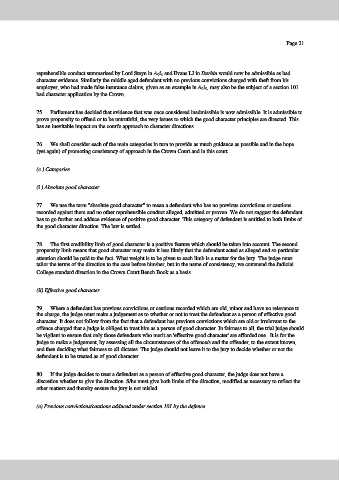Page 429 - Magistrates Conference 2019
P. 429
Page 21
reprehensible conduct summarised by Lord Steyn in Aziz and Evans LJ in Durbin would now be admissible as bad
character evidence. Similarly the middle aged defendant with no previous convictions charged with theft from his
employer, who had made false insurance claims, given as an example in Aziz, may also be the subject of a section 101
bad character application by the Crown.
75. Parliament has decided that evidence that was once considered inadmissible is now admissible. It is admissible to
prove propensity to offend or to be untruthful, the very issues to which the good character principles are directed. This
has an inevitable impact on the court's approach to character directions.
76. We shall consider each of the main categories in turn to provide as much guidance as possible and in the hope
(yet again) of promoting consistency of approach in the Crown Court and in this court.
(c ) Categories
(i.) Absolute good character.
77. We use the term "absolute good character" to mean a defendant who has no previous convictions or cautions
recorded against them and no other reprehensible conduct alleged, admitted or proven. We do not suggest the defendant
has to go further and adduce evidence of positive good character. This category of defendant is entitled to both limbs of
the good character direction. The law is settled.
78. The first credibility limb of good character is a positive feature which should be taken into account. The second
propensity limb means that good character may make it less likely that the defendant acted as alleged and so particular
attention should be paid to the fact. What weight is to be given to each limb is a matter for the jury. The judge must
tailor the terms of the direction to the case before him/her, but in the name of consistency, we commend the Judicial
College standard direction in the Crown Court Bench Book as a basis.
(ii) Effective good character.
79. Where a defendant has previous convictions or cautions recorded which are old, minor and have no relevance to
the charge, the judge must make a judgement as to whether or not to treat the defendant as a person of effective good
character. It does not follow from the fact that a defendant has previous convictions which are old or irrelevant to the
offence charged that a judge is obliged to treat him as a person of good character. In fairness to all, the trial judge should
be vigilant to ensure that only those defendants who merit an 'effective good character' are afforded one. It is for the
judge to make a judgement, by assessing all the circumstances of the offence/s and the offender, to the extent known,
and then deciding what fairness to all dictates. The judge should not leave it to the jury to decide whether or not the
defendant is to be treated as of good character.
80. If the judge decides to treat a defendant as a person of effective good character, the judge does not have a
discretion whether to give the direction. S/he must give both limbs of the direction, modified as necessary to reflect the
other matters and thereby ensure the jury is not misled.
(e) Previous convictions/cautions adduced under section 101 by the defence.

